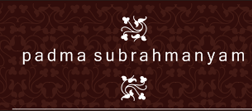

|
(a)
Expansion of the technique through the use of the entire body with
leaps & extension of legs. EXPERIMENTAL CHOREOGRAPHY : Solo
depiction of "Jatayu Moksham" in Ramayana set to the overture
of Tchaikovsky's "Romeo & Juliet". PERFORMER: "Genius", "radical", "crowd puller" - these are some of the words often used to describe Padma Subrahmanyam. She is all these and more……The fact is she stands apart as a dancer……she filled the stage with her presence and alternated between being an "Avatar" of one of the deities she represented and a stone sculpture come alive" - "THE HINDU", Chennai. This is just one of the scores of comments from the press regarding her performances. For five decades, she has been continuously performing extensively in India and abroad. She was perhaps the first artiste who went and performed for our jawans in the forward areas in early sixties. COMPOSER : Padma scores music for most of her productions apart from numerous individual compositions. Her simultaneous conception of her music and movement elevates her productions to a sublime level. SINGER: From childhood, she has had a flair for singing in various Indian and foreign languages. She has sung along with her sister-in-law Shyamala Balakrishnan for a couple of albums titled "Folk Music of Tamilnadu" and "Deiva Tamizh Isai". Padma has also sung "Jayadeva's Ashtapadis" for a separate album. Presently, she sings for many dance performances of her disciples., Dr. Gayatri Kannan (her nephew's wife) is now her co-singer. GURU: Even as a teenager, Padma started teaching at NRITHYODAYA of which she is now the Director. She has evolved a new pedagogy for body training, based on her study of "Natya Sastra" of Sage Bharata. Her disciples get a holistic view of the various aspects of dance art - practical, theoretical, emotional, intellectual and spiritual. She has trained many dancers, teachers as well as musicians as accompanists for dance including "Nattuvangam". ESSENCE OF HER RESEARCH: She is the first to bridge the gap between theory and practice and has revived an obsolete dance technique, translating theoretical concepts into practice. It was Padma who discovered that the "108 Karanas" (basic units of dance) are actually movements and not just static poses. She proved that dance sculptures are like still photographs of moving dancers. She also reconstructed these movements in their entirety through a correlated study of literature, sculptures and inscriptions, coupled with her own self experience as a dancer. SATARA (MAHARASHTRA) & PRAMBANAN (INDONESIA): Padma was ordained by the great Centenarian Sage of this century, Pujyasri Chandrasekharendra Saraswati Swamigal, Jagadguru (68th) Sankaracharya of Kanchi Kamakoti Peetam, to design a new set of 108 Karana sculptures of Lord Siva and Goddess Parvati in black granite, for a temple of Lord Nataraja built recently at Satara in Maharashtra. His Holiness asked her to freeze those movements of the Karanas which are not sculpted in the older temples of Tanjavur, Kumbakonam and Chidambaram (all in Tamilnadu). Padma has made use of 'the twin figures of Siva and Parvati to bring out the animation of each of the Karana movements. Twelve years after completing her design of these 108 Karana figures, she discovered by the grace of the Sage of Kanchi, about fifty Karana sculptures in the world renowned monument-temple complex at Prambanan in Central Java, Indonesia, belonging to the 9th century AD. The remarkable historic feature of these figures is that they totally tally with Padma's practical reconstruction of the Karana movements and also have a great similarity with her own designs for the temple at Satara. She has thus been blessed with an irrefutable proof for the authenticity of her reconstruction of the Karanas. This "link beyond time and space" is the subject of a book by an Italian archaeologist Dr. Alessandra, who did her Post-Doctoral research under Padma, through the British Academy, London. ASIAN LINKS: Apart from discovering candid links between Natya Sastra and Indonesia, Padma realised through the lectures of Pujyasri Mahaswami of Kanchi, the importance of ancient Tamil literature "Tiruppavai" & Tiruvempavai"being used in Thailand, where she used these in her group presentation "Pavai Nonbu", also involving Thai dancers along with her own artistes. She also gave a joint lecture-demonstration on Natya Sastra at the College of Fine Arts, Bangkok along with Achan Chaturong Montri Sat, Thai Professor of Dance. Similarly, her visits to Japan and Australia have considerably strengthened her conviction about Asia’s common cultural links. COUNTRIES VISITED: In the course of the past four decades, Padma has covered many countries for her concert tours, which she uses for her academic research also. She has conducted workshops and taken part in many seminars sponsored by the respective Governments and private organisations. Such countries include USA, Canada, UK, Russia, Germany, France, Greece, Spain, Austria, Portugal, Switzerland, Poland, Mongolia, Dubai, Abu Dhabi, Bahrain, Kuwait, Qatar, Muscat, Mauritius, Afghanistan, Nepal, Srilanka, Singapore, Malaysia, Thailand, Indonesia, Cambodia, Japan, Australia and Fiji Islands
|